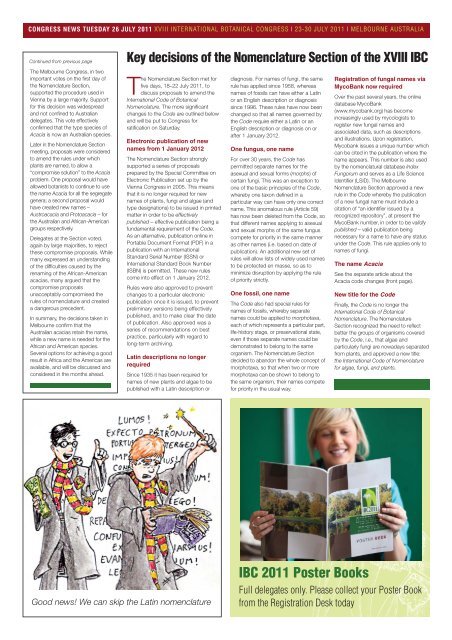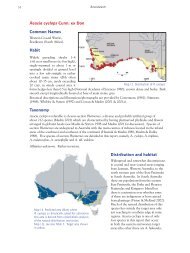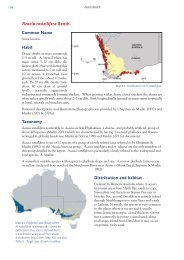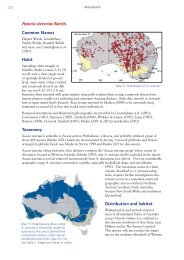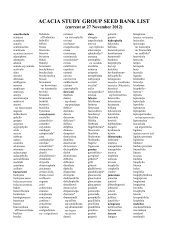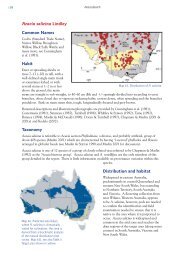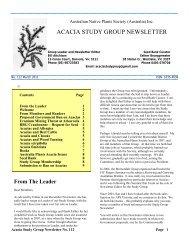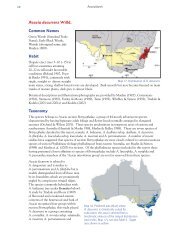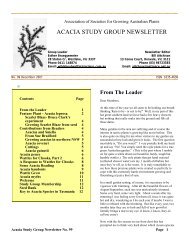The debate
23-30 july 2011 ...xviii international botanical congress - World Wide ...
23-30 july 2011 ...xviii international botanical congress - World Wide ...
You also want an ePaper? Increase the reach of your titles
YUMPU automatically turns print PDFs into web optimized ePapers that Google loves.
CONGRESS NEWS TUESDAY 26 JULY 2011 XVIII INTERNATIONAL BOTANICAL CONGRESS | 23-30 JULY 2011 | MELBOURNE AUSTRALIA<br />
Continued from previous page<br />
Key decisions of the Nomenclature Section of the XVIII IBC<br />
<strong>The</strong> Melbourne Congress, in two<br />
important votes on the first day of<br />
the Nomenclature Section,<br />
supported the procedure used in<br />
Vienna by a large majority. Support<br />
for this decision was widespread<br />
and not confined to Australian<br />
delegates. This vote effectively<br />
confirmed that the type species of<br />
Acacia is now an Australian species.<br />
Later in the Nomenclature Section<br />
meeting, proposals were considered<br />
to amend the rules under which<br />
plants are named, to allow a<br />
“compromise solution” to the Acacia<br />
problem. One proposal would have<br />
allowed botanists to continue to use<br />
the name Acacia for all the segregate<br />
genera; a second proposal would<br />
have created new names –<br />
Austroacacia and Protoacacia – for<br />
the Australian and African-American<br />
groups respectively.<br />
Delegates at the Section voted,<br />
again by large majorities, to reject<br />
these compromise proposals. While<br />
many expressed an understanding<br />
of the difficulties caused by the<br />
renaming of the African-American<br />
acacias, many argued that the<br />
compromise proposals<br />
unacceptably compromised the<br />
rules of nomenclature and created<br />
a dangerous precedent.<br />
In summary, the decisions taken in<br />
Melbourne confirm that the<br />
Australian acacias retain the name,<br />
while a new name is needed for the<br />
African and American species.<br />
Several options for achieving a good<br />
result in Africa and the Americas are<br />
available, and will be discussed and<br />
considered in the months ahead.<br />
<strong>The</strong> Nomenclature Section met for<br />
five days, 18–22 July 2011, to<br />
discuss proposals to amend the<br />
International Code of Botanical<br />
Nomenclature. <strong>The</strong> more significant<br />
changes to the Code are outlined below<br />
and will be put to Congress for<br />
ratification on Saturday.<br />
Electronic publication of new<br />
names from 1 January 2012<br />
<strong>The</strong> Nomenclature Section strongly<br />
supported a series of proposals<br />
prepared by the Special Committee on<br />
Electronic Publication set up by the<br />
Vienna Congress in 2005. This means<br />
that it is no longer required for new<br />
names of plants, fungi and algae (and<br />
type designations) to be issued in printed<br />
matter in order to be effectively<br />
published – effective publication being a<br />
fundamental requirement of the Code.<br />
As an alternative, publication online in<br />
Portable Document Format (PDF) in a<br />
publication with an International<br />
Standard Serial Number (ISSN) or<br />
International Standard Book Number<br />
(ISBN) is permitted. <strong>The</strong>se new rules<br />
come into effect on 1 January 2012.<br />
Rules were also approved to prevent<br />
changes to a particular electronic<br />
publication once it is issued, to prevent<br />
preliminary versions being effectively<br />
published, and to make clear the date<br />
of publication. Also approved was a<br />
series of recommendations on best<br />
practice, particularly with regard to<br />
long-term archiving.<br />
Latin descriptions no longer<br />
required<br />
Since 1935 it has been required for<br />
names of new plants and algae to be<br />
published with a Latin description or<br />
diagnosis. For names of fungi, the same<br />
rule has applied since 1958, whereas<br />
names of fossils can have either a Latin<br />
or an English description or diagnosis<br />
since 1996. <strong>The</strong>se rules have now been<br />
changed so that all names governed by<br />
the Code require either a Latin or an<br />
English description or diagnosis on or<br />
after 1 January 2012.<br />
One fungus, one name<br />
For over 30 years, the Code has<br />
permitted separate names for the<br />
asexual and sexual forms (morphs) of<br />
certain fungi. This was an exception to<br />
one of the basic principles of the Code,<br />
whereby one taxon defined in a<br />
particular way can have only one correct<br />
name. This anomalous rule (Article 59)<br />
has now been deleted from the Code, so<br />
that different names applying to asexual<br />
and sexual morphs of the same fungus<br />
compete for priority in the same manner<br />
as other names (i.e. based on date of<br />
publication). An additional new set of<br />
rules will allow lists of widely used names<br />
to be protected en masse, so as to<br />
minimize disruption by applying the rule<br />
of priority strictly.<br />
One fossil, one name<br />
<strong>The</strong> Code also had special rules for<br />
names of fossils, whereby separate<br />
names could be applied to morphotaxa,<br />
each of which represents a particular part,<br />
life-history stage, or preservational state,<br />
even if those separate names could be<br />
demonstrated to belong to the same<br />
organism. <strong>The</strong> Nomenclature Section<br />
decided to abandon the whole concept of<br />
morphotaxa, so that when two or more<br />
morphotaxa can be shown to belong to<br />
the same organism, their names compete<br />
for priority in the usual way.<br />
Registration of fungal names via<br />
MycoBank now required<br />
Over the past several years, the online<br />
database MycoBank<br />
(www.mycobank.org) has become<br />
increasingly used by mycologists to<br />
register new fungal names and<br />
associated data, such as descriptions<br />
and illustrations. Upon registration,<br />
Mycobank issues a unique number which<br />
can be cited in the publication where the<br />
name appears. This number is also used<br />
by the nomenclatural database Index<br />
Fungorum and serves as a Life Science<br />
Identifier (LSID). <strong>The</strong> Melbourne<br />
Nomenclature Section approved a new<br />
rule in the Code whereby the publication<br />
of a new fungal name must include a<br />
citation of “an identifier issued by a<br />
recognized repository”, at present the<br />
MycoBank number, in order to be validly<br />
published – valid publication being<br />
necessary for a name to have any status<br />
under the Code. This rule applies only to<br />
names of fungi.<br />
<strong>The</strong> name Acacia<br />
See the separate article about the<br />
Acacia code changes (front page).<br />
New title for the Code<br />
Finally, the Code is no longer the<br />
International Code of Botanical<br />
Nomenclature. <strong>The</strong> Nomenclature<br />
Section recognized the need to reflect<br />
better the groups of organisms covered<br />
by the Code, i.e., that algae and<br />
particularly fungi are nowadays separated<br />
from plants, and approved a new title:<br />
the International Code of Nomenclature<br />
for algae, fungi, and plants.<br />
Good news! We can skip the Latin nomenclature<br />
IBC 2011 Poster Books<br />
Full delegates only. Please collect your Poster Book<br />
from the Registration Desk today


